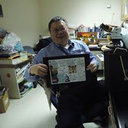Sirtuin 6 suppresses hypoxia-induced inflammatory response in human osteoblasts via inhibition of reactive oxygen species production and glycolysis-A therapeutic implication in inflammatory bone resorption.
الكلمات الدالة
نبذة مختصرة
Elevated glycolytic activity and redox imbalance induced by tissue hypoxia are common phenomena of chronic inflammation, including inflammatory bone diseases such as arthritis. However, relation between glycolysis and redox signaling in the inflammatory milieu is unclear. The histone deacetylase sirtuin 6 (SIRT6) is a crucial modulator of inflammation and glucose metabolism, and it is also involved in cellular protection against oxidative injury. The aims of the study were to examine the connection between glycolysis and reactive oxygen species (ROS) production in human osteoblastic cells (HOB) and whether SIRT6 modulates inflammatory response via regulation of glycolytic activity and ROS generation. In HOB cultured under hypoxia, expression of lactate dehydrogenase A (LDHA), lactate production and ROS generation were examined. The reciprocal effects between lactate and ROS production and their impact on inflammatory cytokine induction were assessed. The action of SIRT6 on the above reactions was determined. In a rat model of collagen-induced arthritis (CIA), the relation between inflammatory activity and osteoblastic expression of LDHA, level of oxidative lesions, Cyr61 synthesis and macrophage recruitment were examined in joints with or without lentiviral-SIRT6 gene therapy. Results showed that hypoxia stress enhanced lactate and LDHA production in HOB. ROS generation was also increased, and there was a positive feedback between glycolysis and ROS formation. Overexpression of SIRT6 attenuated hypoxia-enhanced glycolysis and ROS generation. Hypoxia-induced expressions of Cyr61, TNF-α, IL-1β, and IL-6 were suppressed by SIRT6 and the inhibitory effects overlapped with antiglycolytic and antioxidation mechanisms. In the model of CIA, forced expression of SIRT6 ameliorated disease progression, osteoblastic synthesis of Cyr61, and macrophage recruitment. More importantly, expression of LDHA and oxidative lesions were decreased in osteoblasts of SIRT6-treated joints. Our findings suggest that SIRT6 suppresses inflammatory response in osteoblasts via modulation of glucose metabolism and redox homeostasis. SIRT6-based strategy may possess therapeutic potential for inflammatory bone resorption. © 2016 BioFactors, 43(2):170-180, 2017.


